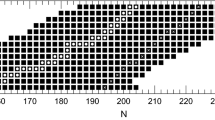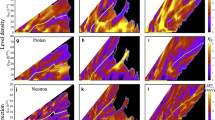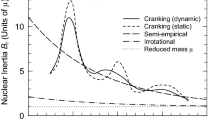Summary
Although the unpaired nucleons in an atomic nucleus exhibit pronounced shell-model-like behavior, the situation with respect to the paired-off « core region » nucleons is considerably more abscure. Several recent « multi-α knockout » and « quasi-fission » experiments indicate that nucleon clustering is prevalent throughout the core region of the nucleus; this same conclusion is suggested by nuclear-binding-energy systematics, by the evidence for a « neutron halo » in heavy nuclei and by the magnetic-moment systematics of low-mass odd-A nuclei. A number of arguments suggests, in turn, that this nucleon clustering is not spherical or spheroidal in shape, as has generally been assumed, but instead is in the form of two-dimensional Ising-like layers, with the layers arrayed perpendicular to the symmetry axis of the nucleus. The effects of this two-dimensional layering are observed most clearly in low-energy-induced fission, where nuclei with an even (odd) number of Ising laysers fission symmetrically (asymmetrically). This picture of the nucleus gives an immediate quantitative explanation for the observed asymmetry in the fission of uranium, and also for the transition from symmetric to asymmetric and back to symmetric fission as the atomic number of the fissioning nucleus increases fromA=197 up toA=258. These results suggest that, in the shell model formulation of the atomic nucleus, the basis states for the paired-off nucleon core region should be modified so as to contain laminar nucleon cluster correlations.
Riassunto
Sebbene i nucleoni non appaiati in un nucleo atomico mostrino un pronunciato comportamento tipo modello a strati, la situazione nei confronti dei nucleoni accoppiati della regione del nocciolo è considerevolmente più oscura. Molti recenti esperimenti sul knockout a molte particelle α e sulla «quasi fissione» indicano che l’aggruppamento dei nucleoni è prevalente per tutta la regione centrale del nucleo; questa stessa conclusione è suggerita dalla sistematica dell’energia di legame, dalla prova di un «alone di neutroni» nei nuclei pesanti e dalla sistematica del momento magnetico dei nuclei a bassa massa e conA dispari. Per contro, un certo numero di argomenti suggerisce che questo aggruppamento di nucleoni non è sferoidale o sferico di forma, come si suppone generalmente, ma è invece della forma di strati bidimensionali del tipo di Ising, con gli strati ordinati perpendicolarmente all’asse di simmetria del nucleo. Gli effetti di questa stratificazione bidimensionale sono osservati più chiaramente nella fissione indotta a bassa energia in cui i nuclei con un numero pari (dispari) di strati di Ising fissionano simmetricamente (asimmetricamente). Questo quadro del nucleo dà un’immediata spiegazione quantitativa dell’asimmetria osservata nella fissione dell’uranio ed anche della transizione da fissione simmetrica ad asimmetrica e di nuovo a simmetrica quando il numero atomico del nucleo di fissione aumenta daA=197 fino adA=258. Questi risultati suggeriscono che, nella formulazione del modello a strati del nucleo atomico, gli stati di base per i nucleoni appaiati della regione del nocciolo dovrebbero essere modificati in modo da contenere correlazioni laminari di nucleoni a grappoli.
Реэюме
Хотя неспаренные нуклоны в атомных ядрах обнаруживают явно выраженное поведение, определяемое оболочечной моделью, ситуация, относяшаяся к нуклонам, спаренным вне « области остова », является не вполне ясной. Некоторые недавние зксперименты по « множественному выбиванию альфа-частиц » и ?кваэи-делению « укаэывают, что нуклонная кластериэация превалирует в области остова ядра. Укаэанное эаключение следует иэ систематики знергий свяэи ядер, иэ сушест-вования « нейтронного гало » в тяжелых ядрах и иэ систематики магнитных моментов легких ядер с нечетным А. Выдвигаются ряд аргументов в польэу того, что нуклонная кластериэация не является сферической или сфероидальной по форме, как, вообше говоря, предполагается, а имеет форму двумерных слоев иэинговского типа. Причем, слои расположены перпендикулярно оси симметрии ядер. Эффекты, свяэанные с обраэованием зтих двумерных слоев наблюдаются более ясно при индуцированном делении при ниэких знергиях, когда ядра с четным (нечетным) числом слоев Иэинга делятся симметрично (асимметрично). Эта картина для ядра дает непосредственное количественное общяснение для наблюденной асимметрии при делении урана, а также для перехода иэ симметричного в асимметричное и обратно в симметричное деление, когда атомный номер деляшегося ядра увеличивается отA=197 доA=258. Эти реэультаты предполагают, что в оболочечной модели атомного ядра основные состояния для нуклонов, спаренных вне области остова, должны быть модифици-рованы таким обраэом, чтобы содержать корреляции ламинарных нуклонных кластеров.
Similar content being viewed by others
References
A. deShalit andH. Feshbach:Theoretical Nuclear Physics. — Vol. I:Nuclear Structure (New York, N. Y., 1974).
D. H. Wilkinson:Proceedings of the Rutherford Jubilee Conference (London, 1961), p. 339.
See, for example,Clustering Phenomena in Nuclei (Vienna, 1969).
See the review byV. V. Balashov:Clustering Phenomena in Nuclei (Vienna, 1969), p. 56.
V.G. Lind, H. S. Plendl, H. O. Funsten, W. J. Kossler, B. J. Lieb, W. F. Lankford andA. J. Buffa:Phys. Rev. Lett.,32, 479 (1974).
H. E. Jackson, L. Meyer-Schützmeister, T. P. Wangler, R. P. Redwine, R. E. Segel, J. Tonn andJ. P. Schiffer:Phys. Rev. Lett.,31, 1353 (1973);H. E. Jackson, D. G. Kovar, L. Meyer-Schützmeister, R. E. Segel, J. P. Schiffer, S. Vigdor, T. P. Wangler, R. L. Burman, D. M. Drake, P. A. M. Gram, R. P. Redwine, V. G. Lind, E. N. Hatch, O. H. Otteson, R. E. McAdams, B. C. Cook andR. B. Clark:Phys. Rev. Lett.,35, 641 (1975);H. E. Jackson, D. G. Kovar, L. Meyer-Schützmeister, S. E. Vigdor, T. P. Wangler, R. E. Segel, J. P. Schiffer, R. L. Burman, P. A. M. Gram, D. M. Drake, V. G. Lind, E. N. Hatch, O. H. Otteson, R. E. McAdams, B. C. Cook andR. B. Clark:Phys. Rev. Lett.,35, 1170 (1975).
C. C. Chang, N. S. Wall andZ. Fraenkel:Phys. Rev. Lett.,33, 1493 (1974).
O. Artun, Y. Cassagnou, R. Legrain, N. Lisbona, L. Roussel, J. P. Alard, A. Baldt, J. P. Costilhes, J. Fargeix, G. Roche andJ. C. Tamain:Phys. Rev. Lett.,35, 773 (1975). See alsoA. M. Poskanzer, R. G. Sextro, A. M. Zebelman, H. H. Gutbrod, A. Sandoval andR. Stock:Phys. Rev. Lett.,35, 1701 (1975).
H. Ullrich, E. T. Boschitz, H. D. Engelhardt andC. W. Lewis:Phys. Rev. Lett.,33, 433 (1974);H. D. Engelhardt: Thesis, Grenoble, 1974 (unpublished).
P. D. Barnes, R. A. Eisenstein, W. C. Lam, J. Miller, R. B. Sutton, M. Eckhouse, J. Kane, R. E. Welsh, D. A. Jenkins, R. J. Powers, R. Kunselman, R. P. Redwine, R. E. Segel andJ. P. Schiffer:Phys. Rev. Lett.,29, 230 (1972).
D. Ashery, M. Zaider, Y. Shamai, S. Cochavi, M. A. Moinester, A. I. Yavin andJ. Alster:Phys. Rev. Lett.,32, 943 (1974).
See, for example,J. Gomez del campo, J. L. C. Ford, jr.,R. L. Robinson, P. H. Stelson andS. T. Thornton:Phys. Rev. C,9, 1258 (1974);R. A. Williams andA. P. Caretto jr.:Phys. Rev. C,10, 601 (1974);D. C. Slater, J. R. Hall, J. R. Calarco, B. A. Watson andJ. A. Becker:Phys. Rev. Lett.,33, 733 (1974).
J. V. Kratz, A. E. Norris andG. T. Seaborg:Phys. Rev. Lett.,33, 502 (1974);R. J. Otto, M. M. Fowler, D. Lee andG. T. Seaborg:Phys. Rev. Lett.,36, 135 (1976).
F. Hanappe, M. Lefort, C. Ngô, J. Péter andB. Tamain:Phys. Rev. Lett.,32, 738 (1974);K. L. Wolf, J. P. Unik, J. R. Huizenga, J. Birkelund, H. Freisleben andV. E. Viola:Phys. Rev. Lett.,33, 1105 (1974);B. Tamain, F. Plasil, C. Ngô, J. Péter, M. Berlanger andF. Hanappe:Phys. Rev. Lett.,36, 18 (1976).
S. K. Chang, M. C. Cheney andN. Sugarman:Phys. Rev. C,10, 2467 (1974).
L. Pauling:Phys. Rev. Lett.,15, 499, 868 (1965);Phys. Rev.,182, 1357 (1969);Nature,208, 174 (1965);Science,150, 297 (1965).
See, for example,P. D. Curry andD. W. L. Sprung:Nucl. Phys.,216 A, 125 (1973);R. M. Mendez-Moreno, M. Moreno andT. H. Seligman:Nucl. Phys.,221 A, 381 (1974);D. M. Brink, H. Friedrich, A. Weiguny andC. W. Wong:Phys. Lett.,33 B, 143 (1970)
D. R. Harrington:Phys. Rev.,147, 685 (1966);J. R. Fulco andD. Y. Wong:Phys. Rev.,172, 1062 (1968);J. V. Noble:Phys. Lett.,31 B, 253 (1970);T. Yukawa andS. Yoshida:Phys. Lett.,33 B, 334 (1970);N. De Takacsy andS. Das Gupta:Phys. Lett.,33 B, 556 (1970);T. K. Lim:Nucl. Phys.,158 A, 385 (1970);W. Zickendrath:Zeits. Phys.,238, 343 (1970);J. Germond andC. Wilkin:Nucl. Phys.,237 A, 477 (1975).
R. K. Sheline andK. Wildermuth:Nucl. Phys.,21, 196 (1960).
K. Wildermuth andTh. Kanellopoulos:Nucl. Phys.,7, 150 (1958).
Ch. Leclerq-Willain andM. Libert-Heinemann:Nucl. Phys.,229 A, 15 (1974);J. V. Noble:Phys. Lett.,55 B, 433 (1975);E. I. Dolinsky, V. V. Turovtsev andR. Yarmukhamedov:Phys. Lett.,33 B, 147 (1970);W. E. Kunz:Phys. Rev.,97, 456 (1955);L. D. Pearlstein, Y. C. Tang andK. Wildermuth:Phys. Rev.,120, 224 (1960).
K. Wildermuth andTh. Kanellopoulos:Nucl. Phys.,9, 449 (1958).
K. Wildermuth andY. C. Tang:Phys. Rev. Lett.,6, 17 (1961).
A. H. Wapstra andN. B. Gove:Nuclear Data Tables,9, 267 (1971).
M. H. Johnson andE. Teller:Phys. Rev.,93, 357 (1954);P. B. Jones:Phil. Mag.,3, 33 (1958);R. G. Seyler andC. H. Blanchard:Phys. Rev.,131, 355 (1963);E. H. S. Burhop:Nucl. Phys.,1 B, 438 (1967);H. A. Bethe:Phys. Rev.,167, 879 (1968);I. Ahmed:Nucl. Phys.,247 A, 418 (1975);G. D. Alkhazov, S. L. Belostotsky, O. A. Domchenkov, Yu. V. Dotsenko, N. P. Kuropatkin, M. A. Schuvaev andA. A. Vorobyov:Phys. Lett.,57 B, 47 (1975).
Y. N. Kim:Mesic Atoms and Nuclear Structure, especially Chap. 5, sect.2 (New York, N. Y., 1971).
C. E. Wiegand:Phys. Rev. Lett.,23, 1235 (1969).
SeeR. D. Evans:The Atomic Nucleus (New York, N. Y., 1955), p. 30.
H. J. Körner andJ. P. Schiffer:Phys. Rev. Lett.,27, 1457 (1971).
G. W. Greenlees, G. J. Pyle andY. C. Tang:Phys. Rev.,171, 1115 (1968).
D. H. Davis, S. P. Lowell, M. Csejthey-Barth, J. Sacton, G. Schorochoff, andM. O’Reilly:Nucl. Phys.,1 B, 434 (1967);W. M. Bugg, G. T. Condo, E. L. Hart, H. O. Cohn andR. D. McCulloch:Phys. Rev. Lett.,31, 475 (1973);W. M. Bugg, G. T. Condo, E. L. Hart, H. O. Cohn andR. D. McCulloch:Nucl. Phys.,64 B, 29 (1973);W. M. Bugg, G. T. Condo, E. L. Hart andH. O. Cohn:Phys. Rev. Lett.,35, 611 (1975).
M. Leon andR. Seki:Phys. Lett.,48 B, 173 (1974);Nucl. Phys.,74 B, 68 (1974).
A. deShalit andH. Feshbach:Theoretical Nuclear Physics. — Vol. I:Nuclear Structure, fig. 8.2 (New York, N. Y., 1974).
V. S. Shirley:Table of nuclear moments, published inHyperfine Interactions in Excited Nuclei, edited byG. Goldring andR. Kalish, Vol.4 (New York, N. Y., 1970), p. 1255;Nuclear moments and nuclear structure, inProceedings of the Osaka Conference, Osaka, Japan, September 1972, edited byH. Horie andK. Sugimoto,Suppl. Journ. Phys. Soc. Japan,34, 602 (1973);P. M. Emdt andC. Van der Leun:Nucl. Phys.,214 A, 1 (1973).
O. B. Dabbousi, M. H. Prior andH. A. Shugart:Phys. Rev. C,3, 1326 (1971);R. L. Williams Jr. andL. Madansky:Phys. Rev. C,3, 2149 (1971);P. A. Moskowitz, C. H. Liu, G. Fulop andH. H. Stroke:Phys. Rev. C,4, 620 (1971);W. L. Randolph jr.,R. R. Borchers, R. Michaelsen, D. W. Haag andW. Ribbe:Phys. Rev. Lett.,27, 603 (1971);K. S. Krane andW. E. Steyert:Phys. Rev. C,6, 2268 (1972);F. Bacon, G. Kaindl, H.-E. Mahnke andD. A. Shirley:Phys. Rev. Lett.,28, 720 (1972);C. V. K. Baba, T. Faestermann, D. B. Fossan andD. Proetel:Phys. Rev. Lett.,29, 496 (1972);B. K. Sinha andR. Bhattacharyya:Phys. Rev. C,7, 350 (1973);R. C. Haskell andL. Madansky:Phys. Rev. C,7, 1277 (1973);R. J. R. Reimann andM. N. Mc Dermott:Phys. Rev. C,7, 2065 (1973);R. C. Hoppa andP. N. Tandon:Phys. Rev. C,10, 744 (1974);R. Brenn, S. K. Bhattacherjee, G. D. Sprouse andL. E. Young:Phys. Rev. C,10, 1414 (1974);G. A. Mariño, G. F. Fulop, W. Groner, P. A. Moskowitz, O. Redi andH. H. Stroke:Phys. Rev. Lett.,34, 625 (1975);M. Forterre, J. Gerber, J. P. Vivien, M. B. Goldberg, K.-H. Speidel andP. N. Tandon:Phys. Rev. C,11, 1976 (1975);J. W. Hugg, T. Minamisono, D. G. Mavis, T. K. Saylor, H. F. Glavish andS. S. Hanna:Bull. Amer. Phys. Soc.,20, 1163 (1975);R. J. Mitchell, T. V. Ragland andR. P. Scharenberg:Bull. Amer. Phys. Soc.,20, 1163 (1975);D. B. Fossan, R. E. Shroy, A. K. Gaigalas andG. Schatz:Bull. Amer. Phys. Soc.,20, 1187 (1975);A. Iordachescu, E. A. Ivanov andG. Pascovici:Phys. Lett.,48 B, 28 (1974);M. Forterre, J. Gerber, J. P. Vivien, M. B. Goldberg andK.-H. Speidel:Phys. Lett.,55 B, 56 (1975);S. S. Rosenblum andW. A. Steyert:Phys. Lett.,55 B, 450 (1975);H. Haas, E. Ivanov andE. Recknagel:Phys. Lett.,58 B, 423 (1975);M. Haas, H. T. King andE. Ventura:Phys. Lett.,59 B, 32 (1975);R. Avida, I. Ben-Zvi, G. Goldring, S. S. Hanna, P. N. Tandon andY. Wolfson:Nucl. Phys.,182 A, 359 (1972);M. Kaplan, P. Kittel, P. D. Johnston andN. J. Stone:Nucl. Phys.,193 A, 410 (1972);C. Ekström, S. Ingelman, M. Olsmats andB. Wannberg:Nucl. Phys.,194 A, 237 (1972);K. H. Maier:Nucl. Phys.,195 A, 577 (1972);C. Ekström, W. Hogervorst, S. Ingelman andG. Wannberg:Nucl. Phys.,226 A, 219 (1974);H. Hübel, C. Günther, K. Euler, N. Bräuer: andD. Riegel:Nucl. Phys.,227 A, 421 (1974);J. L. Eberhardt, R. E. Horstman, H. W. Heeman andG. Van Middlekoop:Nucl. Phys.,229 A, 162 (1974);J. R. Beene, J. Asher, N. Ayres de Campos, R. D. Gill, M. A. Grace andW. L. Randolph:Nucl. Phys.,230 A, 141 (1974);F. Brandolini, C. Rossi Alvarez, G. B. Vingiani andM. De Poli:Lett. Nuovo Cimento,12, 433 (1975);P. W. Daly, R. L. A. Gorling, P. W. Martin andB. G. Turrell:Can. Journ. Phys.,50, 2373 (1972);W. Fischer, H. Hühnermann andK. Mandrek:Zeits. Phys.,254, 127 (1972);B. Singh, A. K. Dhar, V. Singh andH. S. Hans:Journ. Prys. Soc. Japan,33, 898 (1972).
SeeJ. M. Ziman:Principles of the Theory of Solids (Cambridge, 1972), p. 353.
S. A. Moszkowski:Handbüch der Physik, Vol.34 (Berlin, 1957), p. 498 (italics were inserted by the present author).
The 2010 Ne, 2412 Mg and 2814 Si shapes are from the (p, p) measurements ofR. De Swiniarski, C. Glashausser, D. L. Hendrie, J. Sherman, A. D. Bacher andE. A. McClatchie:Phys. Rev. Lett.,23, 317 (1969); the 16669 Tm shape is fromK. E. G. Löbner, M. Vetter andV. Hönig:Nuclear Data Tables,7 A, 495 (1970); the 17872 Hf shape is fromD. L. Hendrie, N. K. Glendenning, B. G. Harvey, O. N. Jarvis, H. H. Duhm, J. Saudinos andJ. Mahoney:Phys. Lett.,26 B, 127 (1968); the 23090 Th and 23892 U shapes are fromF. K. McGowan, C. E. Bemis jr.,J. L. C. Ford jr.,W. T. Milner, R. L. Robinson andP. H. Stelson:Phys. Rev. Lett.,27, 1741 (1971).
M. H. Mac Gregor:Nuovo Cimento,20 A, 471 (1974);Phys. Rev. D,13, 574 (1976), shows that the lifetimes of the so-called « weakly decaying particles » follow an accurate scaling in α=e 2/ħc, which suggests that these decays are in some fundamental sense electromagnetic.
L. Gray, P. Hagerty andT. Kalogeropoulos:Phys. Rev. Lett.,26, 1491 (1971). The\(\overline p n\) bound state reported in this experiment has a binding energy of 4.4%, the largest binding energy ever measured. The mass of this resonance is accurately reproduced by assigning this same binding energy to the constituent nucleon quarks.
V. F. Weisskopf:Phys. Today, 17 (August 1970).
M. H. Mac Gregor:Phys. Rev. D,9, 1259 (1974);10, 850 (1974).
From the positive sign of the deuteron electric-quadrupole moment,De Shalit andFeshbach in ref. (1), p. 14, show the deuteron with the two nucleons placed end to end. This would certainly be the configuration if the only charge in the deuteron is the overall positive charge carried by the proton. But, if the proton and the neutron have multiple charges, as indicated in appendix A of the present paper, then the determination of the nucleon configuration becomes considerably more complex.
R. J. Powers, F. Boehm, P. Vogel, A. Zehnder, T. King, A. R. Kunselman, P. Robertson, P. Martin, G. H. Miller, R. E. Welsh andD. A. Jenkins:Phys. Rev. Lett.,34, 492 (1975) (muonic X-rays); see alsoJ. Heisenberg: inProceedings of the International Conference on Nuclear Physics, Munich, Germany, 1973, edited byJ. de Boer andH. J. Mang (Amsterdam, 1973) (electron scattering).
C. D. Zafiratos:Scientific American,227, 100 (October 1972).
E. K. Hyde:The Nuclear Properties of the Heavy Elements. - III:Fission Phenomena (Englewood Cliffs, N. J., 1964), p. 344.
W. Swiatecki:Phys. Rev.,100, 936 (1955).
K. Wolfsberg andG. P. Ford:Phys. Rev. C,3, 1333 (1971).
K. F. Flynn, B. Srinivasan, O. K. Manuel andL. E. Glendenin:Phys. Rev. C,6, 2211 (1972).
K. F. Flynn, E. P. Horwitz, C. A. A. Blomquist, R. F. Barnes, R. K. Sjoblom, P. R. Fields andL. E. Glendenin:Phys. Rev. C,5, 1725 (1972).
W. John, E. K. Hulet, R. W. Lougheed andJ. J. Wesolowski:Phys. Rev. Lett.,27, 45 (1971);K. F. Flynn, J. E. Gindler andL. E. Glendenin:Phys. Rev. C,12, 1478 (1975).
E. K. Hyde:The Nuclear Properties of the Heavy Elements. - III:Fission Phenomena (Englewood Cliffs, N. J., 1964), p. 131.
L. D. Roberts andJ. W. T. Dabbs:Ann. Rev. Nucl. Sci.,11, 175 (1961).
M. G. Mustafa:Phys. Rev. C,11, 1059 (1975), and references cited therein;K. F. Flynn, J. E. Gindler, R. K. Sjoblom andL. E. Glendenin:Phys. Rev. C,11, 1676 (1975).
S. L. Whetstone jr.:Phys. Rev.,114, 581 (1959);J. S. Fraser andJ. C. D. Milton:Phys. Rev.,93, 818 (1954).
A. Turkevitch andJ. B. Niday:Phys. Rev.,84, 52 (1951);R. C. Jensen andA. W. Fairhall:Phys. Rev.,109, 942 (1958).
L. Wilets:Theories of Nuclear Fission (Oxford, 1964), fig. 1.5, p. 8.
R. C. Jensen andA. W. Fairhall:Phys. Rev.,109, 942 (1958); see alsoJ. Maruhn andW. Greiner:Phys. Rev. Lett.,32, 548 (1974).
L. Wilets:Theories of Nuclear Fission (Oxford, 1964), p. 2.
L. Wilets:Theories of Nuclear Fission (Oxford, 1964), p. 10.
L. Wilets:Theories of Nuclear Fission (Oxford, 1964), fig. 1.6, p. 11.
V. V. Vladimirskii:Sov. Phys. JETP,5, 673 (1957).
H. Doubre, J. C. Roynett, J. C. Jacmart, N. Poffé, M. Riou, E. Plagnol andP. de Saintignon:Phys. Rev. Lett.,35, 508 (1975).
K. L. Wolf, J. R. Huizenga, J. Birkelund, H. Freiesleben andV. E. Viola:Bull. Amer. Phys. Soc.,21, 31 (1976).
R. Albrecht, W. Dünnweber, G. Graw, H. Ho, S. G. Steadman andJ. P. Wurm:Phys. Rev. Lett.,34, 1400 (1975).
W. U. Schröder, J. R. Birkelund, J. R. Huizenga, K. L. Wolf, J. P. Unik andV. E. Viola jr.:Phys. Rev. Lett.,36, 514 (1976).
M. H. Mac Gregor: invited papers,Coral Gables Conference on Fundamental Interactions at High Energy (New York, N. Y., 1971), fig. 10.
In ref. (42), a valueW 12=±1.7 MeV for the quark-quark magnetic-interaction energy is deduced from the Σ0 → Λ+γ decay. However, if a slightly different clustering of the quarks is assumed, the valueW 12=±2.3 MeV is obtained. The valueW 12=±2 MeV quoted here is an average of these two extremes. The essential point, however, is not the precise value to be ascribed toW 12, but rather the fact that this completely independent determination of the quark-quark magnetic-interaction strength is of the proper magnitude to bind the α-particle.
B. T. Field:Models of Elementary Particles (Waltham, Mass., 1969), p. 339.
For example, seeW. R. Smythe:Static and Dynamic Electricity (New York, N. Y., 1939).
The original version of the present paper, UCRL 76895, May 29 (1975), describes these calculations in more detail.
Author information
Authors and Affiliations
Additional information
Work performed under the auspices of the U.S.E.R.D.A.
Rights and permissions
About this article
Cite this article
Mac Gregor, M.H. Evidence for two-dimensional ising structure in atomic nuclei. Nuov Cim A 36, 113–170 (1976). https://doi.org/10.1007/BF02724571
Received:
Published:
Issue Date:
DOI: https://doi.org/10.1007/BF02724571




